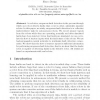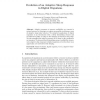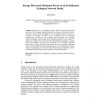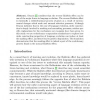111
Voted
ECAL
2007
Springer
15 years 2 months ago
2007
Springer
In robotics, exogenous fault detection is the process through which one robot detects faults that occur in other, physically separate robots. In this paper, we study exogenous faul...
101
Voted
ECAL
2007
Springer
15 years 4 months ago
2007
Springer
Recent development in tethered airfoil i.e. kite technology allows the possibility of exploitation of wind energy at higher altitudes than achievable with traditional wind turbines...
116
Voted
ECAL
2007
Springer
15 years 4 months ago
2007
Springer
Abstract. The colonies of certain species of ants, for example Pogonomyrmex barbatus, exhibit changes in behaviour as the colonies grow older, despite nearly all of the individual ...
121
Voted
ECAL
2007
Springer
15 years 4 months ago
2007
Springer
This paper examines the effects of lifetime learning on the diversity and fitness of a population. Our experiments measure the phenotypic diversity of populations evolving by purel...
133
Voted
ECAL
2007
Springer
15 years 4 months ago
2007
Springer
Abstract. In the context of situated and embodied cognition, we evaluate an information-theoretic approach to the construction of the Umwelt of an artificial agent. We make the ass...
85
Voted
ECAL
2007
Springer
15 years 4 months ago
2007
Springer
Abstract. In previous work [4] a framework was demonstrated that allows an autonomous robot to automatically synthesize physically-realistic models of its own body. Here it is demo...
109
Voted
ECAL
2007
Springer
15 years 4 months ago
2007
Springer
Adaptive responses to resource availability are common in natural systems. In this paper we explore one possible evolutionary cause of adaptive sleep/wake behavior. We subjected po...
102
click to vote
ECAL
2007
Springer
15 years 4 months ago
2007
Springer
Abstract. An important goal in cognitive development research is an understanding of the real-world physical and social environment in which learning takes place. However, the rele...
113
Voted
ECAL
2007
Springer
15 years 4 months ago
2007
Springer
Energy flows in ecological systems which are determined by the structure of the ecological network influence the evolution of the network itself. The total system energy throughflo...
113
Voted
ECAL
2007
Springer
15 years 4 months ago
2007
Springer
Deacon [1] considers that the reverse Baldwin effect can be one of the major forces in language evolution. The reverse Baldwin effect is essentially a redistributional process of g...




